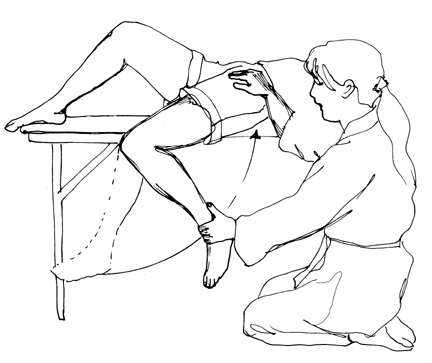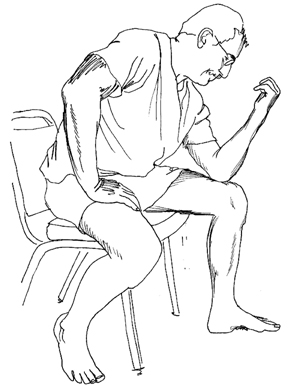Muscles and Knee PainTests and Treatment for Rectus Femoris (Quadriceps)Back to the Introduction
A complete list of tests and treatments will be available in the upcoming book Surviving Martial Arts. Knee Pain Due to the Rectus Femoris Muscle
Symptoms. Pain in the front and center of the knee, particularly when walking downstairs or downhill, or when wearing high heels. Difficulty extending the hip or fully flexing the knee. There are also leg locks and pins that specifically take advantage of tight quads. (Note: The vastus intermedius muscle, lies beneath the rectus femoris. This "forgotten quadricep" tends to cause more problems walking upstairs or up hill and refers pain to the upper thigh. When tight, these two muscles together can cause the hip to buckle when you straighten your knee and step back.)  About the Muscle. This common problem originates in the rectus femoris muscle in the front of the thigh. The rectus femoris (one of the quadriceps muscles) runs from the front edge of the pelvis down to the front of the shin, just below the knee. (The "X" in the picture indicates the most likely trigger point, but notice that the pain is concentrated on and just above the knee, far from where the pain actually originates.) When this muscle is tight and shortened by trigger points (areas where fibers are abnormally shortened) it tends to pull the pelvis forward, creating a "sway back," an anterior (forward) rotation of the pelvis. It also forces the knees back into hyper-extension, causing strain on the cruciate ligaments of the knee as well as other muscles and connective tissues. The sway back or "bubble-butt" figure is very commonly seen in female gymnasts and ballerinas, in soccer players and others who develop powerful thigh muscles especially in those who conscientiously stretch out their hamstrings. Think of the pelvis as a pulley. The quads pull down on it from the front. The hamstrings pull down on it from the back. Ideally there is a balance between the two muscle groups. But . . . when rectus femoris is tight it will rotate the pelvis forward. Simply stretching out the hamstrings alone will increase any problems with anterior pelvic tilt. To avoid this, rectus femoris must also be stretched. Unfortunately, because the rectus femoris crosses two joints (hip and knee), it is rarely stretched out fully. Testing for Rectus Femoris ProblemsTest 1: The Swayback Test
A quick test for a tight rectus femoris is the Swayback Test.
While there may be a little space, too much space, such as space for a hand, or (worse) a whole arm, is not good. The more space beneath the small of the back, the more likely that there is anterior rotation of the pelvis, hence problems with the rectus femoris muscle. Test 2: Heel-To-Butt Test
To test for tight rectus femoris, with help from a partner,

TreatmentPressure TreatmentA rectus femoris with decreased range of motion probably contains trigger points. To self-treat this muscle:  1. Sit in a chair.
1. Sit in a chair.2. Place same-side elbow a few inches above the middle of your knee cap. 3. Gently press into the muscle at various points from the knee up to the attachment point on the pelvis. Trigger points are most commonly found in the upper portion near the hip. Note that trigger points always hurt when pressed, but not everything that hurts is a trigger point. Feel for distinct areas of swellings or nodules. These areas may range in size from a pea to a walnut. 4. Hold gentle pressure on the tender area until the pain subsides.
Notice in the pain pattern diagram that the main trigger point is just below the muscle attachment near the hip. For that point, it is easiest to have a partner apply pressure. Or, to self-treat, you can place a tennis ball on the floor or wall and lie or lean against the point. Remember, gentle (but firm) pressure is best! After pressure treatment, the muscle must be stretched. StretchingOnce you have treated the muscle, stretching should be done at least once every (waking) hour for several days. Stretching should not hurt. Do each stretch 3 times, holding each one for 3-5 seconds. Always treat and stretch the muscles on both sides.
|
catalog | order form | mailing list | e-mail | home
www.round-earth.com
 Lie on your back on a
firm surface with your legs straight. Relax. Imagine for a moment
that you are lying in warm sand at the beach.
Lie on your back on a
firm surface with your legs straight. Relax. Imagine for a moment
that you are lying in warm sand at the beach.